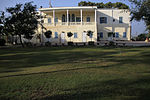Nitzan Bet
2007 establishments in IsraelCommunity settlementsHof Ashkelon Regional CouncilPopulated places established in 2007Populated places in Southern District (Israel)

Nitzan Bet (Hebrew: ניצן ב') is a community settlement in southern Israel. Located between Ashdod and Ashkelon, next to Nitzan, it falls under the jurisdiction of Hof Ashkelon Regional Council and had a population of 376 in 2021.
Excerpt from the Wikipedia article Nitzan Bet (License: CC BY-SA 3.0, Authors, Images).Nitzan Bet
מורד הנחל, Hof Ashkelon Regional Council
Geographical coordinates (GPS) Address Nearby Places Show on map
Geographical coordinates (GPS)
| Latitude | Longitude |
|---|---|
| N 31.736388888889 ° | E 34.636666666667 ° |
Address
מורד הנחל
מורד הנחל
7751619 Hof Ashkelon Regional Council
South District, Israel
Open on Google Maps










